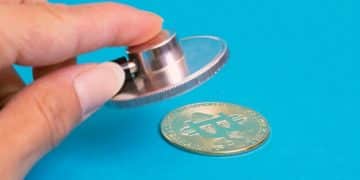SECURE Act 2.0: Boosting Your Retirement Savings in 401(k)s

The SECURE Act 2.0 aims to boost retirement savings by expanding automatic enrollment in 401(k) plans, increasing the age for required minimum distributions, and offering more flexibility for individuals to save for retirement.
Are you looking to enhance your retirement savings? The Retirement Savings Boost: Understanding the SECURE Act 2.0’s Impact on Your 401(k) offers multiple avenues for individuals to bolster their savings, offering a significant opportunity to optimize your financial future.
Understanding the SECURE Act 2.0: A Game Changer for Retirement Savers
The SECURE Act 2.0 represents a substantial update to the original SECURE Act, building upon its foundation to further enhance retirement savings opportunities. This legislation, enacted to address the evolving needs of retirees and those planning for retirement, introduces several key provisions designed to make saving easier and more accessible.
These changes encompass a wide range of areas, from adjustments to required minimum distribution (RMD) ages to the expansion of automatic enrollment in employer-sponsored retirement plans. By understanding the core components of the SECURE Act 2.0, individuals can make informed decisions about their retirement savings strategies and take full advantage of the benefits offered.
Key Provisions of the SECURE Act 2.0
The SECURE Act 2.0 includes several provisions aimed at enhancing retirement savings. Some of the most significant changes involve:
- Increased RMD Age: The age at which individuals must begin taking required minimum distributions (RMDs) from their retirement accounts has been raised, providing more flexibility.
- Expanded Automatic Enrollment: Many employers are now required to automatically enroll eligible employees in their 401(k) plans, promoting participation.
- Enhanced Contribution Limits: The Act includes provisions that allow for increased contribution limits, especially for those nearing retirement.
- Part-Time Worker Eligibility: Reduced service requirements make it easier for long-term, part-time workers to participate in employer-sponsored retirement plans.
These key provisions collectively contribute to creating a more supportive environment for retirement savings, enabling individuals to build a more secure financial future.
In summary, the SECURE Act 2.0 brings significant updates that can benefit retirement savers, providing more flexibility, easier access to retirement plans, and enhanced savings opportunities.
Automatic Enrollment: A Push Towards Greater Participation
One of the most impactful changes introduced by the SECURE Act 2.0 is the expansion of automatic enrollment in 401(k) and other employer-sponsored retirement plans. The aim is simple: to boost participation rates and ensure that more Americans are saving for their future.
Automatic enrollment addresses the inertia that often prevents individuals from actively signing up for retirement plans. By automatically enrolling employees, employers can overcome this barrier and encourage more people to start saving earlier in their careers.
How Automatic Enrollment Works
Under the SECURE Act 2.0, many employers are required to automatically enroll eligible employees in their retirement plans. Here’s a breakdown of how this process typically works:
- Default Contribution Rate: Employees are automatically enrolled with a default contribution rate, often between 3% and 6% of their salary.
- Employee Choice: Employees have the option to opt out of automatic enrollment or adjust their contribution rate at any time.
- Employer Responsibilities: Employers must provide employees with sufficient notice about the automatic enrollment and their right to opt out.
This system is designed to make saving for retirement the default option, encouraging more individuals to take advantage of employer-sponsored plans.

In conclusion, automatic enrollment is a crucial component of the SECURE Act 2.0, designed to increase participation in retirement plans and help more Americans secure their financial future.
RMD Age Adjustments: Giving Retirees More Flexibility
The SECURE Act 2.0 includes significant changes to the age at which individuals must begin taking required minimum distributions (RMDs) from their retirement accounts. These adjustments provide retirees with greater flexibility in managing their savings and potentially reduce their tax burden.
The original SECURE Act had already increased the RMD age from 70 ½ to 72. The SECURE Act 2.0 takes this a step further, gradually raising the RMD age to 73, and eventually to 75. This allows individuals to keep their retirement funds invested for a longer period, potentially benefiting from continued growth.
By delaying the onset of RMDs, retirees can also avoid potentially higher tax brackets and manage their taxable income more effectively. This increased flexibility is a welcome change for many retirees.
Impact of Delayed RMDs
The delayed RMD age has several benefits for retirees:
- Continued Growth: Retirement funds can continue to grow tax-deferred for a longer period.
- Tax Management: Retirees can better manage their taxable income by controlling when they withdraw funds.
- Flexibility: Increased flexibility in managing retirement savings to meet individual needs.
These advantages make the RMD age adjustments a valuable component of the SECURE Act 2.0, providing retirees with greater control over their financial resources.
Overall, the RMD age adjustments in the SECURE Act 2.0 are a positive development for retirees, offering increased flexibility and potential tax benefits.
Enhanced Contribution Limits: Maximizing Savings Potential
The SECURE Act 2.0 also includes provisions that enhance contribution limits to retirement accounts, allowing individuals to save even more for their future. These changes are particularly beneficial for those nearing retirement, providing an opportunity to catch up on their savings.
One of the key enhancements is the introduction of higher catch-up contribution limits for individuals aged 60 to 63. This allows those in this age range to contribute more than the standard annual limit, providing a significant boost to their retirement savings.
These enhanced contribution limits are designed to encourage individuals to maximize their savings potential and take full advantage of the tax benefits offered by retirement accounts.

Benefits of Higher Contribution Limits
The higher contribution limits offer several advantages:
- Accelerated Savings: Individuals can accelerate their retirement savings in their peak earning years.
- Tax Advantages: Contributions to retirement accounts are often tax-deductible or tax-deferred, providing significant tax benefits.
- Financial Security: Increased savings can lead to greater financial security in retirement.
These benefits make the enhanced contribution limits a valuable feature of the SECURE Act 2.0, helping individuals build a more robust retirement nest egg.
In summary, the enhanced contribution limits in the SECURE Act 2.0 offer a valuable opportunity for individuals to maximize their retirement savings and secure their financial future.
Part-Time Worker Eligibility: Expanding Access to Retirement Plans
The SECURE Act 2.0 addresses the long-standing issue of part-time worker eligibility for employer-sponsored retirement plans. By reducing the service requirements, the Act makes it easier for long-term, part-time employees to participate in these plans.
Previously, part-time workers often faced significant hurdles in accessing retirement benefits due to stringent eligibility criteria. The SECURE Act 2.0 lowers these barriers, allowing more part-time employees to save for retirement through their employer’s plan.
This change is particularly beneficial for workers in industries with a high proportion of part-time employees, such as retail, hospitality, and healthcare.
Impact on Part-Time Workers
The expanded eligibility for part-time workers has several positive impacts:
- Increased Participation: More part-time workers can participate in employer-sponsored retirement plans.
- Financial Security: Access to retirement savings plans can improve the financial security of part-time workers.
- Equitable Benefits: Part-time workers receive more equitable access to retirement benefits compared to full-time employees.
These impacts make the expanded eligibility for part-time workers a significant achievement of the SECURE Act 2.0, promoting greater financial inclusion.
Overall, the SECURE Act 2.0’s provisions regarding part-time worker eligibility represent a positive step towards ensuring that more employees have access to retirement savings plans, regardless of their employment status.
Planning Your Retirement Strategy Under the SECURE Act 2.0
With the SECURE Act 2.0 bringing significant changes to retirement savings, it’s crucial to reassess your retirement strategy to take full advantage of the new opportunities. This involves understanding how the Act’s provisions impact your specific financial situation and making adjustments accordingly.
Begin by reviewing your current retirement savings plan and assessing how the increased RMD age, enhanced contribution limits, and other provisions of the SECURE Act 2.0 can benefit you. Consider consulting with a financial advisor to develop a personalized retirement strategy tailored to your needs.
Effective planning will ensure you maximize the benefits offered by the SECURE Act 2.0 and achieve your retirement goals.
Steps to Optimize Your Retirement Plan
Here are some steps you can take to optimize your retirement plan under the SECURE Act 2.0:
- Review Contribution Rate: Increase your contribution rate to take advantage of the enhanced contribution limits.
- Assess RMD Impact: Evaluate how the delayed RMD age affects your tax planning and withdrawal strategy.
- Consider Automatic Enrollment: If your employer offers automatic enrollment, understand your options and make informed decisions.
- Seek Professional Advice: Consult with a financial advisor to develop a comprehensive retirement plan.
By following these steps, you can ensure that your retirement plan is aligned with the provisions of the SECURE Act 2.0 and optimized for your financial success.
In conclusion, planning your retirement strategy under the SECURE Act 2.0 is essential to maximizing the benefits and achieving your retirement goals. By taking proactive steps and seeking professional advice, you can secure your financial future.
| Key Point | Brief Description |
|---|---|
| ✅ Automatic Enrollment | Employers automatically enroll employees in retirement plans, increasing participation. |
| 🗓️ RMD Age Increase | The age for required minimum distributions is raised, offering more flexibility. |
| 💰 Contribution Limits | Enhanced contribution limits, especially for those nearing retirement. |
| 💼 Part-Time Workers | Easier access to retirement plans for long-term, part-time workers. |
Frequently Asked Questions (FAQ)
▼
The SECURE Act 2.0 is a follow-up to the original SECURE Act, designed to further enhance retirement savings opportunities for Americans by expanding access to retirement plans and increasing savings incentives.
▼
Many employers are now required to automatically enroll eligible employees in their 401(k) plans with a default contribution rate. Employees can opt out or adjust their contribution rate at any time.
▼
The SECURE Act 2.0 raises the age for required minimum distributions (RMDs) from retirement accounts, providing retirees with more flexibility in managing their retirement funds and reducing potential tax burdens.
▼
Yes, the SECURE Act 2.0 includes provisions for higher catch-up contribution limits, especially for individuals aged 60 to 63, allowing them to save more in their retirement accounts.
▼
The Act reduces service requirements, making it easier for long-term, part-time employees to participate in employer-sponsored retirement plans and access retirement savings benefits.
Conclusion
In conclusion, the SECURE Act 2.0 introduces several key changes designed to boost retirement savings for Americans. From expanding automatic enrollment and increasing the age for required minimum distributions to enhancing contribution limits and improving part-time worker eligibility, these provisions collectively offer new opportunities to optimize your retirement plan and secure your financial future; be sure to consult with a financial advisor to tailor a strategy that best fits your individual needs and goals.





